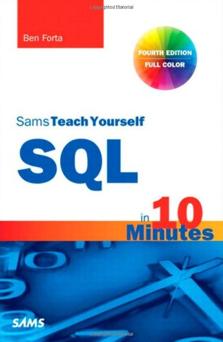| Teach Yourself SQL in 10 Minutes 4th Ed |
Author: Ben Forta Clearly written and sticks to the essentials but in trying to cover SQL in general it could be confusing for some SQL dialects.
The fact this book has reached its fourth edition is an indication that Ben Forta has done a pretty good job of writing a book to introduce novices to SQL. Like all the ’10 minutes’ range, the book is arranged into a sequence of lessons each of which should take around 10 minutes to complete.
Forta starts out with the very basics of databases, but by Lesson Two has moved on to retrieving data using the Select statement, and from there he works his way through SQL. Once Forta has covered all aspects of the Select statement, he goes on to more exotic topics such as data manipulation functions and aggregate functions. At this point he does hit the problem that while a Select statement looks essentially identical whether you’re working in Access, SQL Server, MySQL or Oracle, once you get into functions they all tend to go their own way. This makes the descriptions less easy to follow, but Forta manages his best.
After lessons on grouping data and subqueries, Forta moves on to Joins and Advanced Joins. Given the restrictions of 10-minute lessons, I thought his descriptions were clear and a beginner should understand what a join is and why it’s important. Action queries (insert, update and delete) are tackled next, before the table creation and manipulation queries. The ‘lessons’ part of the book concludes with chapters on views, stored procedures, transaction processing and cursors, with one final chapter on advanced SQL features – constraints, indexes, triggers, and security. For all these last set of lessons, I’d say the material is clearly written, and good in as far as it goes. You’d understand what a cursor is and know the syntax of how to write one, but given the length of the book you’re not going to know the full depths of such complex ideas. The book ends with some substantial appendices, starting with a description of the sample tables used in the scripts, then guides to working with a wide variety of databases, ranging from Apache Open Office Base to SQLite, with the big names covered in between. The guides are limited to information such as ‘Launch SQL Server Management Studio, provide the server and login information, then type the SQL in the large right-hand window’ , but I suppose they at least give you a clue of how to get started. I like Forta’s writing style, and find his descriptions clear and well written. As with all the books in this series, you don’t come out as an expert by working through the lessons, but you would come out as a competent novice, knowing enough to be able to make progress.
|
|||
| Last Updated ( Thursday, 13 June 2013 ) |


